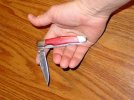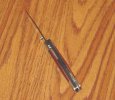- Joined
- Jan 8, 2000
- Messages
- 311
Well, my wife's knife and mine came in just in time for Christmas. While we're both happy with our respective knives, we wouldn't dream of trading.
Kershaw Doublecross:
I got the model 4390, which has a spey blade as the second blade to the primary clip point. It looks very traditional indeed, and the light weight and feel is what is expected from an old fashioned folder. The only give away that this is a liner lock is the slightly scalloped portions of the handle that give better access to the thumbstuds.
The first time I tried to thumb it open, nothing happened, and I wondered if there was something I was supposed to unlock before opening it. After a considerable increase in pressure, the blade popped out as if it were assisted, though not opening all the way without a further slight push. Both blades were equally hard to dislodge from their closed positions, and I found that there is no actual assistance mechanism. Instead, after a brutal initial resistance, the action becomes smooth like one would expect from a thumbstud one hand opening knife.
Upon further inspection, I found the reason for the obstanance: A stamped indentation in the liner-lock fits into what must be a drilled hole in the blade upon closing. Both blades actually make an audible click during the last milimeter of going closed. Since the indentation is stamped, I am going to try to lessen the height with needlenose pliers to see if I can make it more friendly to one hand operation. The open lock up is nice and secure, and closing the knife is as easy as your average liner lock.
The AUS6 blades arrived impressively sharp. I have no tool to measure the angle of the primary bevel, but the fingernail test suggests it is similar to the one on my Chef's knife - ~19 degrees. (I rest the blade lightly on my fingernail, and turn it sideways until it slips off. The smaller the angle of the grind, the farther it leans while still gripping with barely any perceptiple pressure). I was able to push cut through just about any type of paper (except toilet paper) by just pinching the top of the paper and sliding the blade away from my hand along the freestanding top edge at a diagnal downwards. NICE FACTORY EDGE! The blade spine measured .07" on my caliper for both blades, which is thin enough to cut through most soft materials with very little drag. These blades were definitely made to do precision cutting, not prying. These blades are what paring knives should be; I made quick work of beef on the cutting board, the blade moving through so effortlessly it was scary.
As a saving grace to the tough opening, each blade has the traditional notch to get a fingernail on to manually open them (as on the SAK), which when used makes the blades seem too easy to open compared to other knives of this design. If I can't get those indentations down, I will probably remove the thumbstuds and have a very nice traditional knife that glides open and closes with one hand via the liner lock - though with the dimensions of this knife being kind of small, and the blades being scary sharp, I'm a little nervous to close it one handed at the time being.
Overall fit and finish is excellent; the wood inlay has a rich luster, the rivets are smooth and flush, and the knife looks as good as it cuts. Blades lock open securely with no distracting wobble, and the small handle feels familiar like a thin SAK or old folding knife from the toolchest.
Cammilus Wilderness Series Knife:
Ok, I didn't expect too much, but my wife is into bears and this knife had an emblem of a running bear on the side of what I thought were wood inlays on the handle.
Although the knife did come in a nice leather sheath, when I pulled it out I was taken aback at how darned heavy this thing was. The wood inlays turned out to be plastic immitations, and bad ones at that. This knife weighs a TON, and feels like a giant chunk of die cast metal or something.
Opening the blade is a bit of effort, as the action feels about as gritty and heavy as the worst artifact found on the ocean floor. No locking indentations needed by design! Ugh; I would have returned this dog pronto, but my wife fell in love with it so it looks like it stays - on her side of the room!
The blade itself is impressive when opened; an aggresive looking clip point that would scare most sheeple if it was opened in public. By my fingernail test, the edge can only be tilted slightly before sliding right off, indicating it's easily over 30 degrees or simply not that sharp. I couldn't push cut paper at all, but it was able to slice through paper in a draw cut without tearing.
I'll keep you informed if my pliers can get into those pesky closing indentations on the Kershaw and tame the safety factor down a bit.
Kershaw Doublecross:
I got the model 4390, which has a spey blade as the second blade to the primary clip point. It looks very traditional indeed, and the light weight and feel is what is expected from an old fashioned folder. The only give away that this is a liner lock is the slightly scalloped portions of the handle that give better access to the thumbstuds.
The first time I tried to thumb it open, nothing happened, and I wondered if there was something I was supposed to unlock before opening it. After a considerable increase in pressure, the blade popped out as if it were assisted, though not opening all the way without a further slight push. Both blades were equally hard to dislodge from their closed positions, and I found that there is no actual assistance mechanism. Instead, after a brutal initial resistance, the action becomes smooth like one would expect from a thumbstud one hand opening knife.
Upon further inspection, I found the reason for the obstanance: A stamped indentation in the liner-lock fits into what must be a drilled hole in the blade upon closing. Both blades actually make an audible click during the last milimeter of going closed. Since the indentation is stamped, I am going to try to lessen the height with needlenose pliers to see if I can make it more friendly to one hand operation. The open lock up is nice and secure, and closing the knife is as easy as your average liner lock.
The AUS6 blades arrived impressively sharp. I have no tool to measure the angle of the primary bevel, but the fingernail test suggests it is similar to the one on my Chef's knife - ~19 degrees. (I rest the blade lightly on my fingernail, and turn it sideways until it slips off. The smaller the angle of the grind, the farther it leans while still gripping with barely any perceptiple pressure). I was able to push cut through just about any type of paper (except toilet paper) by just pinching the top of the paper and sliding the blade away from my hand along the freestanding top edge at a diagnal downwards. NICE FACTORY EDGE! The blade spine measured .07" on my caliper for both blades, which is thin enough to cut through most soft materials with very little drag. These blades were definitely made to do precision cutting, not prying. These blades are what paring knives should be; I made quick work of beef on the cutting board, the blade moving through so effortlessly it was scary.
As a saving grace to the tough opening, each blade has the traditional notch to get a fingernail on to manually open them (as on the SAK), which when used makes the blades seem too easy to open compared to other knives of this design. If I can't get those indentations down, I will probably remove the thumbstuds and have a very nice traditional knife that glides open and closes with one hand via the liner lock - though with the dimensions of this knife being kind of small, and the blades being scary sharp, I'm a little nervous to close it one handed at the time being.
Overall fit and finish is excellent; the wood inlay has a rich luster, the rivets are smooth and flush, and the knife looks as good as it cuts. Blades lock open securely with no distracting wobble, and the small handle feels familiar like a thin SAK or old folding knife from the toolchest.
Cammilus Wilderness Series Knife:
Ok, I didn't expect too much, but my wife is into bears and this knife had an emblem of a running bear on the side of what I thought were wood inlays on the handle.
Although the knife did come in a nice leather sheath, when I pulled it out I was taken aback at how darned heavy this thing was. The wood inlays turned out to be plastic immitations, and bad ones at that. This knife weighs a TON, and feels like a giant chunk of die cast metal or something.
Opening the blade is a bit of effort, as the action feels about as gritty and heavy as the worst artifact found on the ocean floor. No locking indentations needed by design! Ugh; I would have returned this dog pronto, but my wife fell in love with it so it looks like it stays - on her side of the room!
The blade itself is impressive when opened; an aggresive looking clip point that would scare most sheeple if it was opened in public. By my fingernail test, the edge can only be tilted slightly before sliding right off, indicating it's easily over 30 degrees or simply not that sharp. I couldn't push cut paper at all, but it was able to slice through paper in a draw cut without tearing.
I'll keep you informed if my pliers can get into those pesky closing indentations on the Kershaw and tame the safety factor down a bit.


